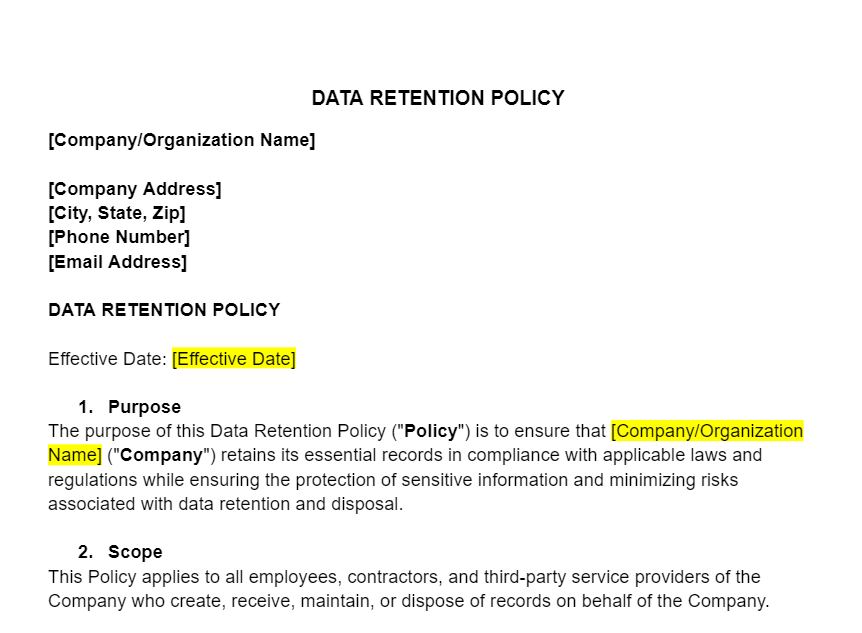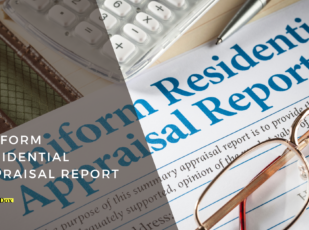
Data Retention Policy Template
16 Downloads
IT and Media
February 17, 2025
Sayantani Dutta
A data retention policy, also known as a records retention policy, is a codified method of maintaining, preserving, and destroying organizational data.
These policies address both operational and legal compliance requirements, ensuring that critical information is retained for an appropriate length of time while being disposed of securely when no longer needed.
An effective data retention policy defines the procedure to be followed in managing data, such as financial statements, medical records, personnel files, and timecards, to meet the requirements of federal laws regarding data retention.
The various policies provided in this respect often include directions on data destruction as a means to reduce the risk of losing it in data breaches and for the protection of privacy standards.
The Objectives of Data Retention
The basic aim of a data retention strategy is to align the retention period of data and records management with regulatory and operational needs. Some data, such as tax records or documents required to be maintained by PCI DSS, need to be retained for very specific periods to remain compliant.
Several datasets require extended retention to meet future business analysis or assessment requirements. Policies should be directed toward improving data management to ensure that records are well stored and available when needed, reducing the chances of noncompliance and enhancing the efficacy of best practices.
Key Organizational Benefits of Adopting Data Retention Policies
The unprecedented expansion of electronic records creates significant difficulties, in particular when retention practices are inadequately defined. If there is no well-framed set of guidelines, an organization is liable to incur unnecessary storage costs, legal vulnerabilities, and data management inefficiencies.
While retaining data such as medical records or financial statements, might inflate storage budgets, early deletion of key records could lead to noncompliance with federal laws. Setting different retention periods for all types of data allows an organization to balance accessibility with secure disposal, meeting both compliance and operational objectives.
Adherence to Compliance Standards
A data retention policy ensures compliance with applicable laws that regulate the length of time personnel records or financial records should be retained. Automation of the compliance processes facilitates regulatory mandates efficiently and minimizes the associated risks of noncompliance penalties.
Cost Optimization
By reducing the amount of obsolete or superfluous data, it minimizes the economic burden on storage resources. Tools like DLM systems can archive data that is no longer active, retaining only what is legally or operationally necessary and reducing storage costs.
Mitigation of Legal Risks
Well-implemented retention policies reduce exposure if litigation arises. By securely disposing of information considered irrelevant or obsolete, businesses reduce the risk of sensitive information being accessed or exploited through legal discovery.
Enhanced Data Usability
Retention policies help in determining data relevance. It enables organizations to remain relevant with datasets related to ongoing business needs; aiding in better decision-making and operations efficiency by regularly purging records that are no longer needed.
Best Practices for Data Retention Policy Development
Legal and Operational Alignment
Retention policies ensure comprehensive compliance by reflecting data retention laws and organizational goals. For example, federal regulations regarding financial statements or tax records can be the basis for developing retention periods, while business-critical datasets would call for longer retention periods.
Customized Retention Schedules
A generic retention policy is inadequate for addressing diverse data types. Each category of data, such as timecards, memoranda, or personnel files, requires a distinct retention timeline. Data-specific guidelines ensure the prevention of over-retention and adherence to legal frameworks in different jurisdictions.
Advanced Archiving Solutions
Modern archiving systems facilitate easier ways of storing and retrieving data. These solutions automate the retention schedules for easier management of archived records and reduce costs related to traditional storage.
Legal Hold Integration
Retention policies should include procedures for halting data destruction when litigation is anticipated. Legal hold mechanisms ensure that subpoenaed data is preserved and not deleted accidentally to protect the organization’s legal standing.
Accessible Documentation
Develop two versions of the retention policy: one formal document that meets all legal and regulatory requirements, and one that is simpler and used internally within the company. This helps develop a dual-documentation approach that provides better understanding among stakeholders and encourages proper retention requirements.
Leveraging Data Lifecycle Management
DLM tools integrated into retention policies enable the organization to retain and dispose of data in an organized manner. These tools automatically handle the retention schedules to ensure data is retained or deleted securely based on predefined criteria.
Dates for the retention or disposal of particular records, such as medical or archived financial statements, are necessary to maintain compliance, while irrelevant records should be disposed of at the right time. Automating these processes not only reduces the risk of data breaches but also ensures better handling of data with stated regulations.
Establishing a Comprehensive Data Retention Policy
Developing a data retention policy is complex and usually requires a multi-disciplinary approach. While many organizations outsource this process to experts, a structured approach is required for those who handle it in-house. A data retention policy identifies the regulatory requirements for the creation of data, aligns these with the goals of the business, and then implements systems for compliance.
Build a Responsible Team
Crafting a data retention policy necessitates collaboration among multiple departments. The development of the policy should be addressed jointly by IT professionals, legal counsel, and key organizational stakeholders. This collaborative effort ensures the policy meets the technical, legal, and operational requirements of the organization.
Define Legal Requirements
This means understanding the legal requirements for data retention. These conditions are different for different industries and their respective regulations, such as HIPAA for healthcare and SOX for financial institutions. This basis of the policy is regulatory mandates, such as SOX, which calls for a minimum retention period of seven years for financial statements.
Identify Business Requirements
The policy should go beyond compliance and address organizational objectives. The data types, such as employee emails, medical records, and financial reports, need to be categorized to identify their appropriate retention periods. Data that is active may eventually go to archives, and policies should indicate how DLM processes handle that transition.
Assign Compliance Responsibilities
Assign different responsibilities regarding monitoring adherence to the policy. Internal audits, as well as periodic assessments, become important factors in ascertaining whether retention schedules and destruction policies are being followed.
Develop Enforcement Mechanisms
Collaborate with other departments, legal or human resources, in laying down the processes for enforcement of this policy. Ensure compliance at the software level through systems configured to manage data according to metadata-driven rules.
Draft and Approve the Policy
After defining the requirements, draft a detailed policy document. This should also spell out the retention schedules, conditions that call for data archiving, and procedures for safe deletion. Present the policy to the stakeholders for review and approval.
Regular Reviews and Revisions
A retention policy is not a static document. Schedule periodic reviews to coincide with the cycle of change in business operations, relevant laws, and technology.
Operational Considerations During Policy Implementation
Proper implementation depends on correctly differentiating between archived data versus backup data. Backups exist to prevent data loss and thus ensure that business operations are not adversely impacted. Metadata can show automated systems when the data should transition to archives or be deleted. Efficient archival storage allows for greater cost-efficacy and ensures accessibility.
Data Retention and Regulatory Compliance
Organizations must develop and implement retention policies that correspond to particular regulatory demands to maintain compliance and operational efficiency.
For instance, according to the Health Insurance Portability and Accountability Act (HIPAA), a healthcare provider must keep all patient records for at least six years. Any organization handling credit card-related transactions must strictly adhere to data retention policies provided by PCI DSS for the safe disposal of personal data.
The European Union’s General Data Protection Regulation enforces strict protocols for handling and storing personal data. Businesses must document which data is retained and its purpose, along with the length of time it’s retained.
This means that compliance with GDPR requires a defined purpose for retaining data, secure disposal of unnecessary information, and transparent documentation of the retention process. In the United States, frameworks like the California Consumer Privacy Act are driving data retention policies to strongly focus on ethical considerations in storage and usage.
The 2023 CPRA Amendment set a limit on retention periods to only what is reasonably necessary for fulfilling specific business purposes, although it does not fix a maximum duration for retaining data.
Differentiating Backup and Archive
Understanding the differences between data backup and data storage is central to forming an effective data retention strategy. Backups are temporal repositories of data kept for disaster recovery and systems restoration. Archives are utilized for the long-term preservation of data that are seldom accessed. A retention policy should account for such differences through the use of DLM and metadata tagging to drive automation in archiving processes and deletion schedules.
Pitfalls in Retention Schedules
Retention schedules must be designed to meet various data retention laws and compliance requirements while ensuring operational efficiency. Specific data, such as contracts or critical agreements, may still hold legal or business value even after their primary use period has ended. Where records have been flagged for deletion, administrators should carefully check to ensure the purpose is accurately captured since deleting an important record can result in its permanent loss.
Importance of Documentation
Establish a formalized retention policy, particularly in regulated industries. Documenting the requirements for compliance ensures repeated and predictable data retention practices. The document must address regulatory obligations and organizational needs in a way that evidences due diligence and reduces the risk of litigation.
Practical Examples of Dat Retention Strategies
Retention duration varies widely, depending on the needs of the organization and compliance requirements.
Email Management
E-mails pile up fast and take up a great deal of storage, thus requiring specified retention periods. IT teams and legal departments should work together to develop compliant email retention schedules.
Storage Solutions
Public cloud solutions can offer an affordable solution for the near or long term. They bring companies additional thanks to the associated offsite security offered by these platforms. For historical data, tape storage has remained a low-power, cost-effective solution, despite slower retrieval speeds.
Overcoming Data Retention Challenges
While automated retention systems are efficient, they must be carefully configured. These challenges can be minimized by developing a retention schedule that fits the needs of the organization and its compliance requirements. The policy should clearly outline storage solutions with optimized cost and resource allocation to match organizational priorities.
Download a Data Retention Policy Template from FreshDox on a Free Trial
Sign up for a free 7-day trial of FreshDox and get immediate access to our archive of IT templates for business. A Basic account gets you three free downloads per week while there are no limitations for Premium accounts. Edit your template to your organization’s requirements and download it in PDF or Word formats. Check out our catalog of professionally designed templates for business and maintain your organization’s regulatory compliance.
Related Templates
Discover more templates that align with your needs and preferences.

Ready to Sign Up?
Sign up for FreshDox.com’s 7-day trial and discover why so many individuals and businesses trust us for their legal document template needs.
- Cancel any time
- 7-day free trial
- From 300+ Customer Reviews
















